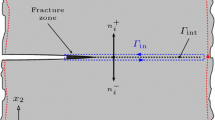Abstract
The problem of fast fracture and crack arrest in rectangular fracture specimens under plane strain conditions is investigated within the confines of linear elastic fracture mechanics. A development consistent with the energy-balance criterion for fracture is obtained by first expressing the strain and kinetic energies in their finite-difference forms. These forms are used in Lagrange's equations and in the definition of the energy release rate to obtain the governing field equations. This development is subsequently used to make predictions that are compared with their measured counterparts. Agreement of predicted and observed compliances of SEN, CT, and DCB specimens is found to be very good. A direct comparison of predicted and measured results is made for a rapid fracture and crack arrest in an Araldite B DCB specimen. The predicted crack growth, crack-time history, and variations of the dynamic stress intensity factor and crack speed with crack length during propagation agree remarkably well with the experimental data.
Résumé
On étudie à l'aide de la mécanique de la rupture linéaire et élastique le problème de la fissure rapide et de l'arrêt de fissuration dans des éprouvettes de rupture rectangulaires soumises à des conditions d'état plan de déformation. Un développement compatible avec le critère d'équilibre de l'énergie pour la rupture est obtenu en exprimant d'abord les déformations et les énergies cynétiques sous des formes de différences finies. Ces formes sont utilisées dans les équations de Lagrange et dans la définition de la vitesse de relaxation d'énergie, afin d'obtenir des équations de champ. Ce développement est ensuite utilisé pour faire des prédictions qui sont comparées avec les mesures expérimentales. Un accord entre les compliances prédites et observées dans le cas d'éprouvettes SEN, CT et DCB, apparait comme particulièrement satisfaisant. Une comparaison directe des résultats prédits et mesurés est effectuée dans le cas d'une rupture rapide et dans le cas d'un arrêt de fissure dans une éprouvette DCB en Araldite B. La vitesse prédite pour la croissance de la fissure, le déroulement de la fissuration, et les variations dans le facteur d'intensité de contraintes dynamiques et dans la vitesse de fissuration en fonction de la longueur de la fissure au cours de la propagation sont en remarquable accord avec les données expérimentales.
Similar content being viewed by others
References
L.B. Freund, Journal of Mechanics and Physics of Solids, 20 (1972) 129.
L.B. Freund, Journal of Mechanics and Physics of Solids, 20 (1972) 141.
L.B. Freund, Journal of Mechanics and Physics of Solids, 21 (1963) 47.
J.D. Achenbach, Mechanics Today, S. Nemat-Nassar (editor), Pergamon Press, New York (1974).
A.S. Kobayashi, S. Mall, and A.F. Emery, Fracture 1977, D.M.R. Taplin (editor), ICF 4, University Press, Waterloo (1977).
P.N.R. Keegstra, J.L. Head and C.E. Turner, Fracture 1977, D.M.R. Taplin (editor), ICF 4, University Press, Waterloo (1977) 515.
M.F. Kanninen, International Journal of Fracture, 10 (1974) 415.
M.F. Kanninen, C. Popelar, and P.C. Gehlen, Fast Fracture and Crack Arrest, ASTM STP, 627 (1977) 19.
P.C. Gehlen, C.H. Popelar, and M.F. Kanninen, International Journal of Fracture, 15 (1979).
M. Shmuely and D. Peretz, International Journal of Solids and Structures, 12 (1976) 67.
J. Aboudi, Comp. Meths. Appl. Mechs. Engr., 9 (1976) 301.
F. Nilsson, Journal of Elasticity, 4 (1974) 73.
G.T. Hahn, P.C. Gehlen, R.G. Hoagland, M.F. Kanninen, C.H. Popelar, and A.R. Rosenfield, Critical Experiments, Measurements and Analyses to Establish a Crack Arrest Methodology, 10th Quarterly Progress Report, Battelle-Columbus Laboratories (1977).
J.C. Newman, 1973, Proceedings of the 1973 Nat. Symposium on Fracture Mechanics Mech., ASTM STP 560, Am. Soc. for Testing and Mats. (1973) 105.
A. Van Der Boogaart, Proc. Conference on Physical Basis of Yield and Fracture (1966) 167.
D.R.J. Owen and D. Shantanam, International Journal of Fracture, 13 (1977) 821.
H. Stöckl and F. Auer, International Journal of Fracture, 12 (1976) 345.
J.F. Kalthoff, J. Beinert, and S. Winkler, Fast Fracture and Crack Arrest, ASTM STP, 627 (1977) 161.
Author information
Authors and Affiliations
Additional information
Part I will be published in the next issue.
Rights and permissions
About this article
Cite this article
Popelar, C.H., Gehlen, P.C. Modeling of dynamic crack propagation: II. Validation of two-dimensional analysis. Int J Fract 15, 159–177 (1979). https://doi.org/10.1007/BF00037831
Received:
Issue Date:
DOI: https://doi.org/10.1007/BF00037831




